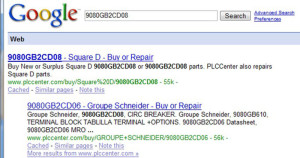Somewhere along the line in my sales and marketing career I’ve gotten very friendly with technology. Several years back I completed a project for an Asset Recovery company that listed over 2 million products on its site. I’m pleased to say that the top selling products enjoyed organic top search ranking. But getting to that point took patience.
A search engine strategy usually goes something like this.Setup our Google AdWords and Yahoo Search Marketing accounts to give the call center an immediate boost.– at a cost. Next, research keywords and phrases that are popular searches in top search engines and write good content using these words and phrases. Be careful not to “stuff” the pages. Somewhere around 10% of your copy containing the key terms is a good rule. Finally, get well indexed sites to link back to you either by link exhange or listing your products for sale on the site with a link pointing to your checkout page for that product. These are some basics.

SCHNEIDER ELECTRIC 9080gb2cd08 CIRCUIT BREAKER Static Landing Page earned additional search engine position
Where you will likely have most of your success is building great landing pages which are crawled via your site map. I’ve had astounding success building product detail landing pages on sites with hundreds of thousands of pages that attract search engines to put products at or near the top of the first page on Google, Yahoo and Bing.
The following method is how I did it, albeit a bit “old school” according to a recent reader comment later in this post. Nevertheless , static landing pages with simplified URL canonical structure will almost always get indexed faster and be more understood by search engine crawls. Further, they can be created without burdening IT with huge chunks of development time. I’m not a programmer by trade but was able to reverse engineer some code to create a web page generator.
Explain to your webmaster that your goal is to get indexed in search engines. e-commerce have products, often lots of them stored in a database. I recommend working with you IT folks to establish a connection to our backend database’ I’ve made a SQL connection to the database and run a Visual Basic routine to loop through product records and outpiut static html pages to a site directory. The number of pages could be 100 or 100 million !

From the search result, visitor lands here and can proceed to checkout. Notice the part number in bold is exactly what they typed in the search engine. The title of the landing page and the name of the file (page) in the site directory is also the part number name.
Wrap the routine with a bit more code, for example, ASP,Java and some html and you’re outputting some pretty awesome product detail pages for the engines to crawl. These are the pages that will eventually appear in the search results for your customers to land on. I suggest building a search feature into each of the pages subtly sugges that you’ve got a lot of products to choose from. Be careful here though. You’ve got the prospect where you want them — In the moment, ready to buy — so be careful not to lead them off the “buy” page. You want them in the cart, adding to the basket where they can always continue shopping.
I would think carefully before building thousands of pages, however. At some point they may become outdated, and they will be lingering on the internet for years. So you’ll want to use Permanent 301 Redirects from these pages if and when that time comes. Jack Mardack from Eventbrite summarized an alternative method.
Jack recommends “a dynamic system builds the pages for you as they are called on the fly, much like a CMS. In fact, if you want to read some possibly-instructive documentation, I would take a look at Drupal and specifically at the Node Import Module — http://drupal.org/handbook/modules/node_import, which allows you to match data input fields from a CSV to output fields on a page template. Very powerful.”

Director, Business Innovation.
Electrical Marketing, LLC
email: gcarter@electricalmarketing.net
CONTACT US: 856.381.7834
eCommerce | Content Development | Strategy & Execution








